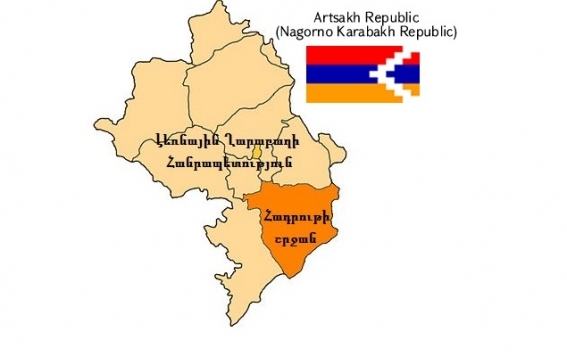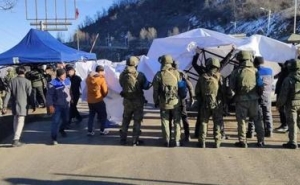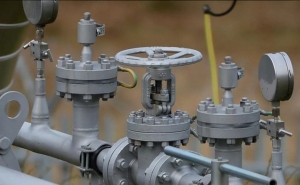Learn More about Artsakh (Nagorno-Karabakh Republic): Hadrut

Hadrut region of Nagorno-Karabakh Republic (NKR) occupies the south-eastern part of the country. It was liberated from Azerbaijani forces in late 1993.
The Area and Population
Hadrut region borders on Martuni, Askeran and Shoushi regions in the north and in the west- on Kashatagh region. The southern boundary runs through the Araks River, which is on the border with Iran. Hadrut region borders on Azerbaijan in the east.
Hadrut occupies about 1876.8 square kilometers. The southern and south-eastern parts of the region are relatively flat. The northern and north-western parts are mountainous, which are covered with mass forests and alpine meadows. The highest peak of NKR, Dizapayt, is also situated here. Ishkhanaget river runs through the region and flows into the Araks River.
According to 2013 data, the Hadrut region is inhabited by 13163 people. In terms of ethnicity, region's population is homogeneous; it is mainly populated by Armenians.
Climate
The climate is generally subtropical dry. The average annual temperature in low-lying areas is +11,7 ° C and in mountainous areas -1 ° C. In January the average temperature is -0,7 ° C and in July +23,6 ° C. The average annual rainfall is 500-700 mm.
Economy
Hadrut region's population is mostly engaged in agriculture - farming. animal husbandry, horticulture. One of the developed sectors of economy is the granite production.
The Administrative Division
Hadrut region has 1 urban, 30 rural communities and 42 rural settlements. In rural areas, the most notable ones are the Tagher, Old Tagher, Togh, Tumi, Azokh, Drakhtik, Ukhtadzore, Taghot, Khtsaberd and Arakyal.
The centeral town of Hadrut region is 75 kilometers far from NKR capital city Stepanakert. The exact date of its foundation is unknown, but on its territory several cultural monuments from pre-Christian era can be seen. It is obvious that in the 16th century Khonashen (Armenian roots cornel and prosperous settlement) had already existed, which was later renamed Hadrut (Mesopotamia). Up to the present day Hadrut's old districts with narrow streets, houses built in 18-19th centuries, 17th century Church of the Holy Resurrection are maintained.
Sightseeings
Hadrut region, which is known in Armenian history as Dizak, is rightly considered a museum in the open air. The region is known for many monastic complexes, churches, ancient settlements and fortresses. It is no coincidence that the famous Armenian actor V.Papazian, being in the Hadrut region, expressed the following idea, which then became Artsakh’s famous expresstions. "If Karabakh is a gold ring, in that case Hadrut is the diamond of that ring’’.
Hadrut region's most famous sights are Gtchavank (XIII century), Azokh Cave, Dizak, which is Yeganyan melics palace (XVIII-XIX centuries), Okhty Drni Monastery, Hadrut Holy Resurrection Church (XVII century), Taghaser settlement (XVII century); Air Marshal, Soviet Union hero Khamferiants’ (Khudyakov) House-Museum in his native village Grand Taghlar.
Yeganyan Meliks’ two-storied palace Dizak is an interesting architectural complex that includes residential and economic areas and Melik Yegan’s reception. Palace complex was gradually built in the 20-30's of the 18th century and was supplemented by new buildings until the mid of 19th century. Despite facing some changes, the palace virtually maintained its original appearance. It gives a clear picture of the 18-19 centuries traditional Caucasus and particularly of the then houses. Since 2009, the palace is in a restoration phase, after which a museum of Artsakh carpets and handicrafts is to be opened.
Gtchavannk was destroyed in the 7th century during the Arab rule and was again re-built in the 13th century by two bishop brothers, Lord Sargis and Lord Vrdanes. In the territory of the complex magnificent khachkars have been maintained, the oldest of which dates back to the ninth century. The church played a significant role in the cultural life of Artsakh. Up to present many valuable manuscripts have been created.
Azokh cave is one of the world's most ancient and famous stopping places. For the first time in the layer of the so-called Acheul archaeological culture hunting stone tools and frescoes were found, which belonged to people who lived and worked here more than three hundred thousand years ago. In southern entrance of the cave, at a depth of seven meters, archaeologists discovered a large piece of Neanderthal jaw.
According to the legend, Okhty Drni Monastery was built by the sister of seven brothers, killed in the struggle against the invaders. Some scholars consider 570s as the date of its construction. Khachkars, the oldest of which dates back to the 10-12th centuries, are maintained in the territory of the monastery.
Other materials on this subject
- Gandzasar: World’s Architectural Masterpiece Today the monastery stand proudly high on the mountains as a symbol of unconquerable will and power of the Armenians, continuing to attack growing number of tourist every year.
- Not Liberated Territories or Something Else, but NKR Regions "Liberated territories" or the use of any other term makes a distinction between the NKR regions, separating the territory of the former Nagorno Karabakh Autonomous Region and surrounding territories....
- Learn More about Artsakh (Nagorno-Karabakh Republic): Shushi Near Shushi one can find one of the most beautiful places in Karabakh – the Gorge of Unotand. The rocky gorge with over three kilometers and with a depth of nearly 250 meters is covered by dense forests...
- Learn More about Artsakh (Nagorno-Karabakh Republic): Martuni Be sure to come to the NKR Martuni region, relax in the shade of an old plane tree, drink homemade wine of Martuni, and you will have a whole new view towards the world - the way it always happens in Karabakh,...
- Learn More about Artsakh (Nagorno-Karabakh Republic): Askeran Askeran region (one of the 8 regions of NKR) occupies the central part of NKR. During the Karabakh war the area was of strategic importance for the security of the NKR’s capital Stepanakert.
-
 17:08
17:08The regular session of the Anti-corruption Policy Council takes place in Jermuk
-
 15:05
15:05The Prime Minister sends congratulatory messages to the supreme leader of Iran and the President of Iran
-
 11:11
11:11Armenia sends earthquake aid to Turkey
-
 10:43
10:43Commemoration of the Pontiff St. Sahak Partev
-
 09:16
09:16Some roads are closed and difficult to pass in Armenia
-
 19:55
19:55Phone conversation of the Foreign Minister of Armenia with the U.S. Assistant Secretary of State for European and Eurasian Affairs
-
 18:30
18:30Prime Minister Pashinyan and President Khachaturyan meet
-
 18:20
18:20Ararat Mirzoyan with Co-Chairman of the OSCE Minsk Group of France Brice Roquefeuil
-
 17:01
17:01Humans could land on Mars within 10 years, Musk predicts
-
 16:45
16:45France, US urge 'immediate' end to Nagorno Karabakh blockade
-
 16:01
16:01Blockaded Nagorno Karabakh launches fundraiser to support quake-hit Syria
-
 15:59
15:59Earthquake death toll in Turkey rises to 18,342
-
 15:43
15:43Ararat Mirzoyan Held a Telephone Conversation with Sergey Lavrov
-
 15:06
15:06French president rules out fighter jet supplies to Ukraine in near future
-
 14:47
14:475 Day Weather Forecast in Armenia
-
 14:44
14:44President Vahagn Khachaturyan wrote a note in the book of condolences opened in the Embassy of Syria in Armenia
-
 14:20
14:20Azerbaijan’s provocations impede establishment of peace and stability – Armenian FM tells Russian Co-Chair of OSCE MG
-
 12:57
12:57France representation to OSCE: Paris calls on Azerbaijan to restore freedom of movement through Lachin corridor
-
 11:40
11:40Command of Kosovo forces highly appreciated preparation of Armenian peacekeepers
-
 10:16
10:16The United States withdrew from sanctions against Syria for six months the provision of assistance after the earthquake
day
week
month
Humidity: %
Wind: km/h









